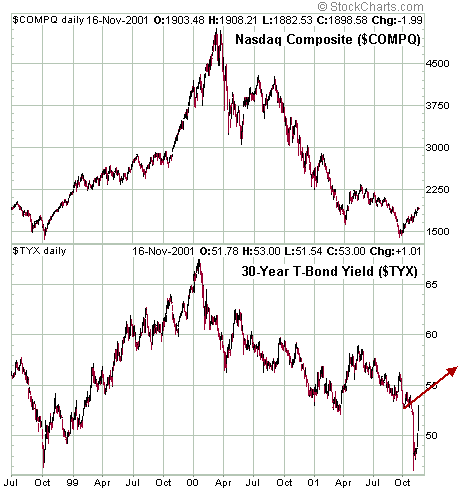
Stocks, Bonds,
and the Marketing of Gold
Below are extracts from commentary
that appeared at www.speculative-investor.com on November 18.
Stocks and Bonds
Today's equity market valuations (price-earnings
ratios) can only be justified if we have low interest rates and
healthy earnings growth. The only way that most large corporations are
going to experience healthy earnings growth is if this year's monetary
expansion gives nominal economic growth a boost next year. However, if
this does happen (we think it will) then interest rates will move considerably
higher. If, on the other hand, the monetary expansion does not have the
desired effect on growth then interest rates would probably head lower.
In this case earnings growth would definitely not be healthy. As
far as the coming 12 months are concerned it looks like low interest rates
and healthy earnings growth - the two pillars capable of supporting such
lofty P/E ratios - will be mutually exclusive.
At the completion of September's panic
sell-off we briefly entertained the idea that THE bear market bottom had
been reached, primarily because sentiment indicators were revealing extremes
of fear that had only ever occurred near the bottoms of major bear markets.
However, as noted in prior commentaries important bottoms in the stock
market almost always occur in parallel with intermediate-term peaks in
interest rates. The action of the past few months, with interest rates
and stocks declining together, is not what we would expect to see near
the bottom of a bear market. It is, however, consistent with the expected
behaviour of markets that remain under the influence of a stupendous credit
bubble.
Below is a chart comparison of the
NASDAQ Composite Index and the T-Bond Yield from July-1998 to the present
day. In a 'normal' environment the major stock indices spend most of their
time trending in the opposite direction to long-term interest rates (falling
interest rates are good for stocks, rising interest rates are bad). During
a credit bubble this relationship is turned on its head.

The above chart makes two things immediately
apparent. First, that the markets have not behaved in a normal manner
over the past 3 years because stock prices have trended in the same
direction as interest rates (we call this the "bubble trend"). Second,
that someone who went to sleep in early-November 1998 and woke up 3 years
later would, upon checking the current level of interest rates and the
NASDAQ Comp., conclude that very little happened while they were asleep.
Stocks and bonds are now almost exactly where they were 3 years ago.
During the past 3 years there have
been periods when stocks and interest rates moved inversely to each other
(for example, stocks have rallied since late-September in parallel with
falling interest rates). However, the major trends have always been in
the same direction, meaning that the recent decline in interest rates resulted
in a temporary divergence that had to be closed either by stocks moving
lower or by interest rates moving higher (assuming the bubble trend remained
in force). Last week's sharp decline in bonds (rise in interest rates)
is probably the bond market beginning to move back 'on trend'.
In summary, the current action appears
to be a continuation of the bubble trend. A major bear market bottom has
probably not been reached and won't occur until the underlying credit bubble
bursts.
Marketing Gold
The World Gold Council, an organisation
representing and funded by gold producers, is planning to spend a huge
sum of money (up to US$200M) promoting the non-monetary uses of gold (eg,
gold jewelry). This is a complete waste of money because a) around 75%
of the world's above-ground gold stock is held for monetary/investment
purposes, and b) the non-monetary demand for gold moves inversely to the
gold price (demand rises when the price falls), meaning that the only sure
way to increase the non-monetary use of gold is to push the gold price
down.
Using the above-mentioned $200M to
publicise gold's monetary/investment qualities would also be a complete
waste of money. This is because the interest of the average investor (the
general public) is only stimulated by a rising price. For example, it wouldn't
have mattered how much money was spent marketing S&P500 Index Funds
during 1982 because, after many years of sub-standard performance, very
few people had any interest in the stock market. It took years of rising
prices to stimulate that interest, with investment demand increasing as
stock prices rose and peaking last year after stock prices had reached
their most unattractive valuations in history. It will be the same story
with gold. The people who wouldn't dream of buying gold at $275 will start
to become interested above $400 and will be aggressive buyers above $800.
This may appear to be a "catch 22"
situation in that most people won't buy until after the price rises, but
some buying is obviously needed to cause the price to rise. It is not,
however, because the initial buying is done by a group of smart investors
based on their assessment of value and/or their understanding that trends
are about to change. When this value-oriented buying begins to become evident
in price action, trend-following speculators start to be drawn to the market.
The last group to buy is always the general public. All the marketing in
the world is not going to change this process.
Regular financial market forecasts
and
analyses are provided at our web site:
http://www.speculative-investor.com/new/index.html
One-month free trial available.

|

